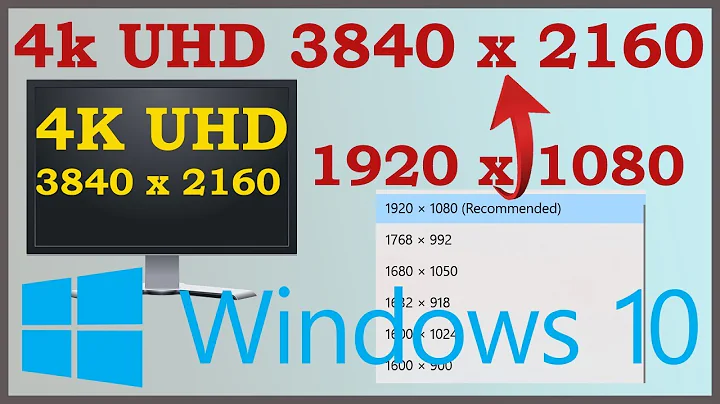How to find the maximum resolution supported by the graphics card?
Solution 1
If it's a CRT monitor then don't worry - all resolutions look crisp. If it's a TFT monitor, then see how its interpolation implementation holds up. I imagine the picture will be fine for the most part, but text might look a bit ugly (I recommend disabling ClearType in this case).
A video card's maximum resolution used to be a function of the size of its framebuffer (back in the 1990s when video cards only had 2-4MB of RAM which meant a screen size of 1024x768 @ 24bpp (1024*768*3 == 2.25MB). However this is a historical footnote and is of no relevance today.
I read up on the Intel 945 Express chipset and its described as only supporting SVDO and VGA output. SVDO is used for the built-in panel, so VGA is the output port.
1600x1200 sounds like a reasonable maximum for VGA on a laptop - this is because of the quality of the DACs required, and the good-quality circuitry required to drive anything higher. VGA has a maximum ceiling of 1920x1440 which my desktops are capable of - I used to use 21" CRTs and I ran them at 1920x1440 at times - but the signal wasn't really stable enough for quality work, so I ran at 1600x1200 most of the time.
For some reason TFT panels always display worse images of the same analoge VGA signal compared to CRTs - so even if you could force it to 1920x1440 (or 1920x1080) I'm sure you'll find the picture quality abysmal.
So when you do get a VGA monitor that runs at 1920x1080, I'd make it run at 1600x1080 (you can force custom resolutions (below the maximum) by tweaking some files - that way you won't get any pixel scaling and you'll get a reasonably sized workspace. You could try forcing it to run at 1920x1080 but the driver might reject it and fallback to 640x480.
If you'd like a 16:9 workspace regardless, then try disabling interpolation and running in 1:1 pixel mapping on your monitor - but your workspace will be a couple of inches smaller than if you didn't.
Does your laptop have a PCMCIA or PCI-Express card slot? It might be worth getting a card for that which supports higher resolutions (and DVI, instead of VGA). Such as http://sewelldirect.com/vtbookpcmciacard.asp
There are also USB video-cards available - but performance on them isn't great. They're only really useful for office work. They might stutter when it comes to web-browsing too. Your call. (but personally - I'd just replace the laptop. Even low-end
Solution 2
On Linux, you can use the commandline tool
xrandr
This will show the maximum resolution of your graphics card
Solution 3
Yes, you have the 945 express chipset, but you have either:
Intel® 945GT Graphics or
Intel® 945G/GZ Graphics
Both have a maximum supported resolution of 1920 x 1080.
See page 28 of the PDF document Intel 945G/945GZ/945GC/945P/945PL Express Chipset Family for 945G/GZ/GT.
Related videos on Youtube
seugnimod
Updated on September 18, 2022Comments
-
 seugnimod over 1 year
seugnimod over 1 yearSo, I am making an app that will allow me to input some data on the client side, whether phone or another desktop running in the same network.
I have a Node.js server, which answers my requests, but I can't actually "read" them in the server side.
this is my code for the server
var http = require("http"); var parseString = require('xml2js').parseString; var express = require('express') var app = express(); var port = process.env.PORT || 8081; var request = require('request'); app.use(function(req, res, next) { res.header("Access-Control-Allow-Origin", "*"); res.header("Access-Control-Allow-Headers", "Origin, X-Requested-With, Content-Type, Accept"); next(); }); // start the server app.listen(port); console.log('Server started! At http://localhost:' + port); // routes will go here app.use('/static', express.static('.')); var bodyParser = require('body-parser'); app.use('/browse', bodyParser.json()); // support json encoded bodies app.use('/browse', bodyParser.urlencoded({ extended: true })); // support encoded bodies app.get('/', function(req, res, next) { // Handle the get for this route }); app.post('/', function(req, res, next) { // Handle the post for this route }); // POST http://localhost:8081/browse app.get('/browse', function(req, res) { var browseRequest = req.body.browseRequest; console.dir("browseRequest: "); console.dir(browseRequest); res.send(JSON.stringify("response")); });(do I have redundant stuff here?)
And this is the part I am using for my html page
// Create the XHR object. function createCORSRequest(method, url) { var xhr = new XMLHttpRequest(); if ("withCredentials" in xhr) { // XHR for Chrome/Firefox/Opera/Safari. xhr.open(method, url, true); } else if (typeof XDomainRequest != "undefined") { // XDomainRequest for IE. xhr = new XDomainRequest(); xhr.open(method, url); } else { // CORS not supported. xhr = null; } return xhr; } // Make the actual CORS request. function makeCorsRequest() { // This is a sample server that supports CORS. var url = "http://192.168.0.100:8081/browse" var xhr = createCORSRequest('GET', url); if (!xhr) { alert('CORS not supported'); return; } //xhr.setRequestHeader("Content-Type", "application/json;charset=UTF-8"); var req = { "browseRequest": { "name": "Aaron", "type": "Consumer", "age": 21 }}; xhr.send(JSON.stringify(req)); }I get the string sent by the server on my client, but I can't access the browserequest in the server because req.body is coming blank.
What am I missing here? Thanks !
-
 Kevin B over 7 yearsyou failed to tell the server what you were sending it. (the commented out part)
Kevin B over 7 yearsyou failed to tell the server what you were sending it. (the commented out part) -
 seugnimod over 7 yearsI commented it before because I was getting CORS error. Even with it uncommented I still have the body empty. Any tip ?
seugnimod over 7 yearsI commented it before because I was getting CORS error. Even with it uncommented I still have the body empty. Any tip ?
-
-
 Kevin B over 7 yearsIt is possible to send a JSON body with a GET request, and body-parser does support this.
Kevin B over 7 yearsIt is possible to send a JSON body with a GET request, and body-parser does support this. -
Steeve Pitis over 7 yearsCould you send me a working example making an ajax get call with a json body ... I'm not sure the browser allow passing body in a GET request... (I know it's possible with CURL)
-
 seugnimod over 7 yearsThanks for your input Steve. I would also like to see that example @Kevin.
seugnimod over 7 yearsThanks for your input Steve. I would also like to see that example @Kevin. -
 Kevin B over 7 yearsMost web browsers won't allow it.
Kevin B over 7 yearsMost web browsers won't allow it. -
Steeve Pitis over 7 yearsSo this downvote isn't necessary. Because this answer will solve his problem.
-
 seugnimod over 7 yearsHey guys. I just switched it to POST and it works the way I was doing. I was almost sure I tried it before but it didn't work. Thanks both of you
seugnimod over 7 yearsHey guys. I just switched it to POST and it works the way I was doing. I was almost sure I tried it before but it didn't work. Thanks both of you


![How to Overclock Your Laptop Monitor [Intel HD Graphics + Nvidia GPU]](https://i.ytimg.com/vi/SLIriAGvy9E/hq720.jpg?sqp=-oaymwEcCNAFEJQDSFXyq4qpAw4IARUAAIhCGAFwAcABBg==&rs=AOn4CLCbKL5HfBEvaJKL966Y1jtHfNgDRg)

